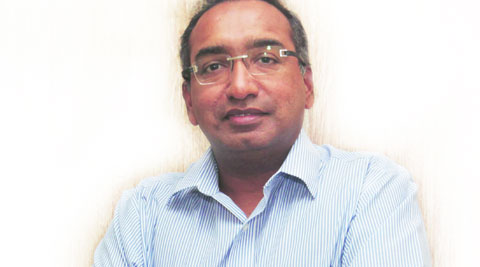Click here to follow Screen Digital on YouTube and stay updated with the latest from the world of cinema.
‘We will focus on both Television and Movies’
Sameer Nair who is back as group CEO of Balaji Telefilms Ltd., talks about his chequered career and the changes taking place in the entertainment industry
 Sameer Nair
Sameer Nair
He is the man who took Star Plus to the number one position with a little help from Balaji Telefilms, the television and film production company of Ekta Kapoor, way back in 2000. As programming head of Star Plus, Sameer Nair brought in two new shows, Kaun Banega Crorepati (KBC), the Indian version of international game show, Who Wants to Be A Millionaire, and Kyunki Saas Bhi Kabhi Bahu Thi, the first of the so-called K-serials from Balaji Telefilms, changing the face of television entertainment in India in the process. Today, Nair is back serving the broadcast industry in a new avatar as Group CEO of Balaji Telefilms.
Meanwhile, the Indian media and entertainment industry has evolved considerably. From `513 billion in 2007, it is expected to reach `1040 billion by 2014-end. In the year 2000 when Star Plus launched the K-serials, the number of television channels stood at 132. In 2007, when Nair quit Star Plus to join NDTV Imagine as its CEO, there were about 402 channels. By 2011, the year Nair quit Imagine TV, the number had already increased to over 500. Today, the number of television channels in the country stands at 788. The film industry has also grown substantially, from `105 billion in 2008 to an estimated `138 billion in 2014.
It is in this changed environment that Nair is looking at making Balaji an entertainment powerhouse. He believes that Balaji has the right assets, reserves, ambition and appetite to crack the content code and exploit the various media platforms that are aggressively seeking growth. Today, the company occupies a strong position in the television content creation space and has diversified into motion pictures, internet and mobile space. In the first quarter of FY2015, consolidated revenues of Balaji Telefilms stood at `135.34 crore while for Balaji Motion Pictures Ltd, revenues stood at `89.39 crore. While the focus will be on the television content business, he will also be looking at investing in films. In a conversation with Anindita Sarkar, Nair talks about his plans. Edited excerpts:
What are your plans for Balaji?
There will be focus on both TV and the movie business. In the last 20 years, Ekta Kapoor and Shobha Kapoor have built a really solid business and my coming here at this time is quite well-timed. They are looking to grow and for me it is better to work with an established platform from where we can grow further.
The more the number of screens and distribution platforms, the better it is for a company such as Balaji. The TV business, movie business and content business are growing and Balaji has the ability to act on those opportunities. So the goal is to scale the business and diversify further. We will be looking at collaborating with various media platforms at many levels.
The FY 2015 outlook for Balaji Telefilms is newer show formats for television content through a wholly owned subsidiary and creation of original and diverse content to retain leadership. We want to explore opportunities across channels and languages. For Balaji Motion Pictures, the plan is to create films across budgets. We want to build our film marketing and distribution capabilities and build a diverse movie slate to capture audiences across genres and leverage opportunities in regional markets.
You have been part of the broadcast industry for long and now you are a part of Balaji Telefilms. Is there a role reversal at play?
I have a creative background and for the last two to three years, I have been part of the production business. I have worked very closely with producers when I was working with broadcasters. The difference now is that I can completely empathise with the broadcaster. I understand the kind of challenges that the broadcaster faces and also what it is exactly seeking. I also think that a company such as Balaji can work very closely with the broadcast community to do more and break new ground.
Unlike your Star days, your tenure at NDTV Imagine had its share of problems. Here too, you had worked with Balaji. In hindsight, what do you think went wrong at Imagine?
At the time when Star did whatever it did, the channel was in a different time and space completely and there were only three channels – Star, Zee and Sony – fighting for the pie. Altogether, there would not have been more than 40-50 channels in the country then. It was a different world altogether. Now, by the time Imagine happened, there were already more than 500 channels. Balaji did some pretty good work for Imagine too. Everybody in the Imagine team tried very hard. So, whatever happened to the channel was not because anyone was taking it easy. Soaps are the staple diet of any Hindi GEC and here we did not get that one big soap. If we had that one soap that worked when we had launched the channel, we would be having a very different conversation right now.
You have had a long association with Balaji during your career at Star. How was the collaboration like?
Before Balaji came onto Star, it had made several successful shows in the south. Meanwhile, it also had Hum Paanch, an outstanding success on Zee TV and in the Hindi GEC space in its portfolio. At that time Star Plus was a distinct number three while Sony and Zee TV were the big boys in the game. Star Plus, which till then had been a half-English, half-Hindi kind of a channel, was looking to rapidly penetrate the mass market. That’s when Balaji and Star came into contact through KBC and the two K-soaps. On the same night that KBC was launched, we put Kyunki Saas Bhi Kabhi Bahu Thi on air. We then brought in Kahaani Ghar Ghar Kii. These two were designed to be the staple and the shows met the exact programming need that was required at that time. As we moved on, Star Plus and Balaji did a lot of soaps together. In fact, Balaji and Star Plus can take full credit for introducing the daily soap format into prime-time.
The market has evolved since then. What are the changes you see in the media and entertainment industry, especially television?
If I am to consider the television, film and media industries as one big entity, it has become bigger. The number of addressable homes have grown and so have the number of direct-to-homes. Evidently, subscription revenues are growing upwards. Sport again has definitely come forward in the last three years and continues to move ahead. Three years back, we would consider a Rs.100-crore movie a stellar box-office hit. Today, that number has already crossed the Rs.200 crore-mark. Not to forget, ticket prices and the number of screens have also moved north. Meanwhile, mobile and internet penetration has also expanded. Clearly, most of the growth in this business is just inevitable.
If one considers the daily soap format, there is no need for it to evolve. But there could be other genres that could grow alongside. For instance, in the 2000s, apart from the daily soaps, there was a sudden rise of reality television. There was a Nach Baliye and then there was a Roadies. Content was suddenly diversifying. So there was this one genre of programming which continued the way it was and then there were the others genres such as stand-up comedies along with the dancing and singing reality shows which were constantly evolving.
Now, 12-13 years on, reality shows display a certain fatigue. Meanwhile, there has been a big rise in sports. All the music channels are doing a new kind of youth programming. A lot of crime programming has also evolved with time.


- 01
- 02
- 03
- 04
- 05
































